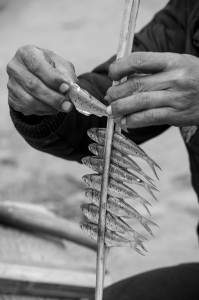 It’s one thing to fall down and another to fall down in mud. But it’s a completely different story when you have an $8000 camera and lens around your neck!
It’s one thing to fall down and another to fall down in mud. But it’s a completely different story when you have an $8000 camera and lens around your neck!
The day didn’t start well.
We were in the far north of Laos and anxious to set off on a 4-day trek to remote tribal villages close to the Chinese border. The 12-hour bus ride from Luang Prabang the previous day had been interesting. Plastic bags were handed out at the beginning of the journey and it wasn’t too long before half the passengers had filled them with their previously consumed breakfast.
My partner, Andrea, gets travel-sick on straight roads at home! It wasn’t fun. The state of the road, the state of the bus and the driver’s suicidal tendency only to overtake on blind bends while answering his cell phone made a mockery of the VIP designation given to the bus. Things could only get better… or so we thought.
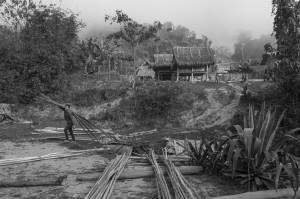 The next morning we headed to the market in Luang Namtha to get a few supplies for the trek. I always carry a camera and slung my Nikon D4 with a 24-70 lens over my shoulder. This f2.8 lens is my workhorse; I use it for as much as 75% of my work. Luang Namtha is not exactly an example of urban pride. Streets are potholed, sidewalks are rudimentary and it rains.
The next morning we headed to the market in Luang Namtha to get a few supplies for the trek. I always carry a camera and slung my Nikon D4 with a 24-70 lens over my shoulder. This f2.8 lens is my workhorse; I use it for as much as 75% of my work. Luang Namtha is not exactly an example of urban pride. Streets are potholed, sidewalks are rudimentary and it rains.
I crossed a street trying to avoid a slick patch of mud and failed spectacularly. My feet shot out from under me; I fell flat on my back, hit my head on the ground and revived an old Achilles tendon problem from several months before. Apart from the damage to my ego (which was bad enough), my D4 hit the ground as hard as I did and the lens snapped in half. The impact also knocked the lens mount out of alignment.
 An inauspicious start to the trek – injured and with only one camera and a 17-35 lens but after that bus ride there was no way I was turning back. I always tell workshop students that, “Equipment gets in the way of photography. Keep things simple.” Now I had to walk the talk.
An inauspicious start to the trek – injured and with only one camera and a 17-35 lens but after that bus ride there was no way I was turning back. I always tell workshop students that, “Equipment gets in the way of photography. Keep things simple.” Now I had to walk the talk.
Very early in my career I switched camera brands from Minolta to Nikon. I had endorsed Minolta cameras from the time I used them covering the British Everest Expedition in 1975 and they gave me anything I asked for. The results were always great but if a camera needed repairing it could take weeks to get it back. I switched to Nikon not for any difference in image quality but for their professional support. I couldn’t afford to replace everything I had in my Minolta outfit so I worked with a very basic Nikon kit. It made me work harder to get the shots I needed and I produced some of the best photographs I had ever taken up to that point. Instead of deliberating on which lens to use I just went with whatever was on the camera. It was a very liberating experience.
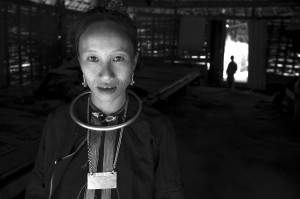 Now here I was, in a place I had never visited before and maybe never would again and all I had was a glorified point and shoot. Fortunately, I have always favored wide lenses. I am a documentary photojournalist and I love to get close to the action and become part of it as opposed to the voyeuristic perspective created with long lenses. A bigger problem was my mobility. Carrying a 40lb pack up steep trails was too much for my tendon and after the first day I had to find a villager to carry the pack for me. Even without it the going was tough.
Now here I was, in a place I had never visited before and maybe never would again and all I had was a glorified point and shoot. Fortunately, I have always favored wide lenses. I am a documentary photojournalist and I love to get close to the action and become part of it as opposed to the voyeuristic perspective created with long lenses. A bigger problem was my mobility. Carrying a 40lb pack up steep trails was too much for my tendon and after the first day I had to find a villager to carry the pack for me. Even without it the going was tough.
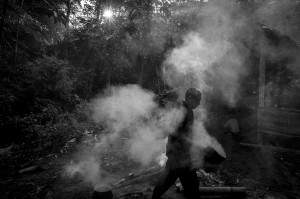 We had just finished teaching an incredible workshop in Myanmar. It was my third visit and each time I come back with better photographs than the time before, always in color. All my professional life I have been a color photographer shooting for magazines, books and agencies and Myanmar is a colorful country.
We had just finished teaching an incredible workshop in Myanmar. It was my third visit and each time I come back with better photographs than the time before, always in color. All my professional life I have been a color photographer shooting for magazines, books and agencies and Myanmar is a colorful country.
Laos was something completely different and as much as I liked the country, I didn’t find it visually stimulating. I like places with an “edge” and that was missing in the Laos we were seeing. Northern Laos beckoned. Here, in the infamous Golden Triangle, remote villages are home to many different ethnic groups of tribal people and this was the magnet.
Cultural photography, if it’s to have any meaning, necessitates connection with the subject. Approaching other cultures as if they are animals in a zoo is not only ethically reprehensible but creates a barrier that prevents a truly engaging record.
 The tourist doing a country a day is never going to have any real understanding of the places they visit. I have been a travel journalist for over 30 years and I get intensely irritated by travel writers who visit a destination for a week and become instant experts. It happens far too often to the detriment of much travel journalism.
The tourist doing a country a day is never going to have any real understanding of the places they visit. I have been a travel journalist for over 30 years and I get intensely irritated by travel writers who visit a destination for a week and become instant experts. It happens far too often to the detriment of much travel journalism.
I remember spending a week in Bermuda with Bill Garrett, the former editor of National Geographic Magazine, shooting for the Bermuda Tourist Office and he complained that he didn’t normally pick up a camera until he had spent at least a couple of weeks in a place. How could he possibly take photographs with any depth?
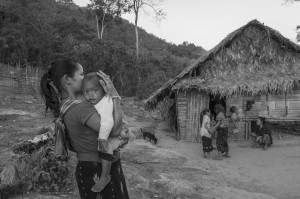 I have friends, professional travel photographers no less, who collect countries. The more the better. Personally I would rather spend 6 months in one country than visit 10 countries in 6 months. I have been to some countries several times and I still feel that I have only scratched the surface. I believe you never really know a place until you have lived there. However, an open and inquiring mind can certainly help bridge the gap.
I have friends, professional travel photographers no less, who collect countries. The more the better. Personally I would rather spend 6 months in one country than visit 10 countries in 6 months. I have been to some countries several times and I still feel that I have only scratched the surface. I believe you never really know a place until you have lived there. However, an open and inquiring mind can certainly help bridge the gap.
Our visit to Laos was brief, just 3 weeks, but it was enough time to make an effort to engage with the tribal groups we were visiting. We ate and slept in the villages, interacted with the people and, even with a language barrier, attempted to communicate. Only with this approach was I able to work with the wide lens and create photographs with intimacy.
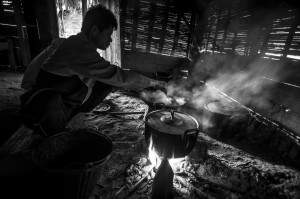 These remote villages were not particularly colorful and one of the beauties of digital photography is that conversion from color to black and white is available with a couple of keystrokes. I tried it with a few frames and the transformation was spectacular.
These remote villages were not particularly colorful and one of the beauties of digital photography is that conversion from color to black and white is available with a couple of keystrokes. I tried it with a few frames and the transformation was spectacular.
Relatively ordinary shots suddenly became powerful images. When I first became a serious photographer in my teens I worked in black and white. My favorite photographers have usually been black and white shooters – Penn, Cartier Bresson, Salgado, and Avedon. The reality of making a living as an editorial magazine photographer necessitated shooting in color and for decades I neglected my black and white roots.
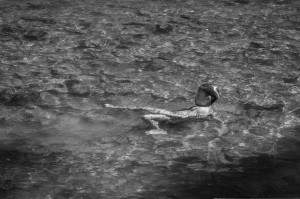 In Laos I came the full circle; back to using a simple, basic outfit and shooting in black and white. It was a refreshing and cathartic experience resulting in some of the most satisfying photography I have done for several years.
In Laos I came the full circle; back to using a simple, basic outfit and shooting in black and white. It was a refreshing and cathartic experience resulting in some of the most satisfying photography I have done for several years.
Nothing keeps creative juices flowing more than a meaningful personal project.
